MARIANI’S
Virtual Gourmet
April 24, 2016
NEWSLETTER
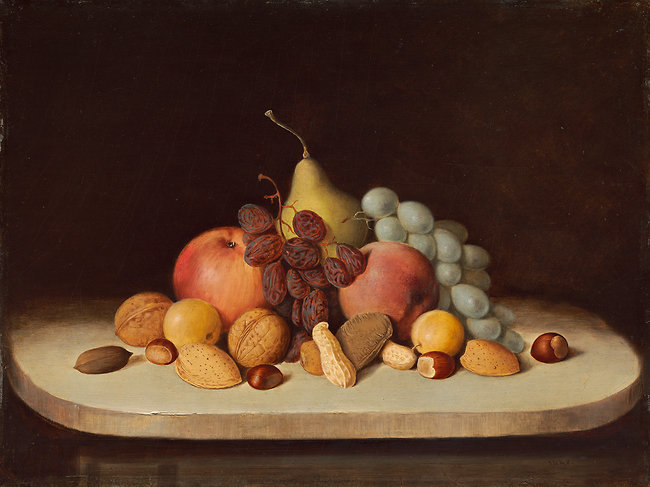
"Still Life" (1848) by Robert Seldon Duncanson
❖❖❖
IN THIS ISSUE
SOUTH AFRICA, Part One
By Brian Freedman
NEW YORK CORNER
SAN CARLO OSTERIA PIEMONTE
By John Mariani
NOTES FROM THE WINE CELLAR
ALEXANDER VALLEY, Part Two
By Geoff Kalish
❖❖❖
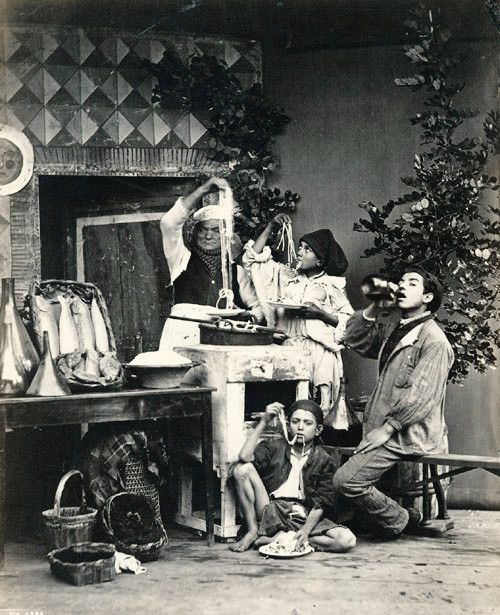
ANNOUNCEMENT: There will be no issue of Mariani's Virtual Gourmet Newsletter next week (May 1st) because Mariani will be eating his way around Rome, Naples, and the Amalfi Coast so that he might write about it all in upcoming issues.
❖❖❖
SOUTH AFRICA, Part One
By Brian Freedman
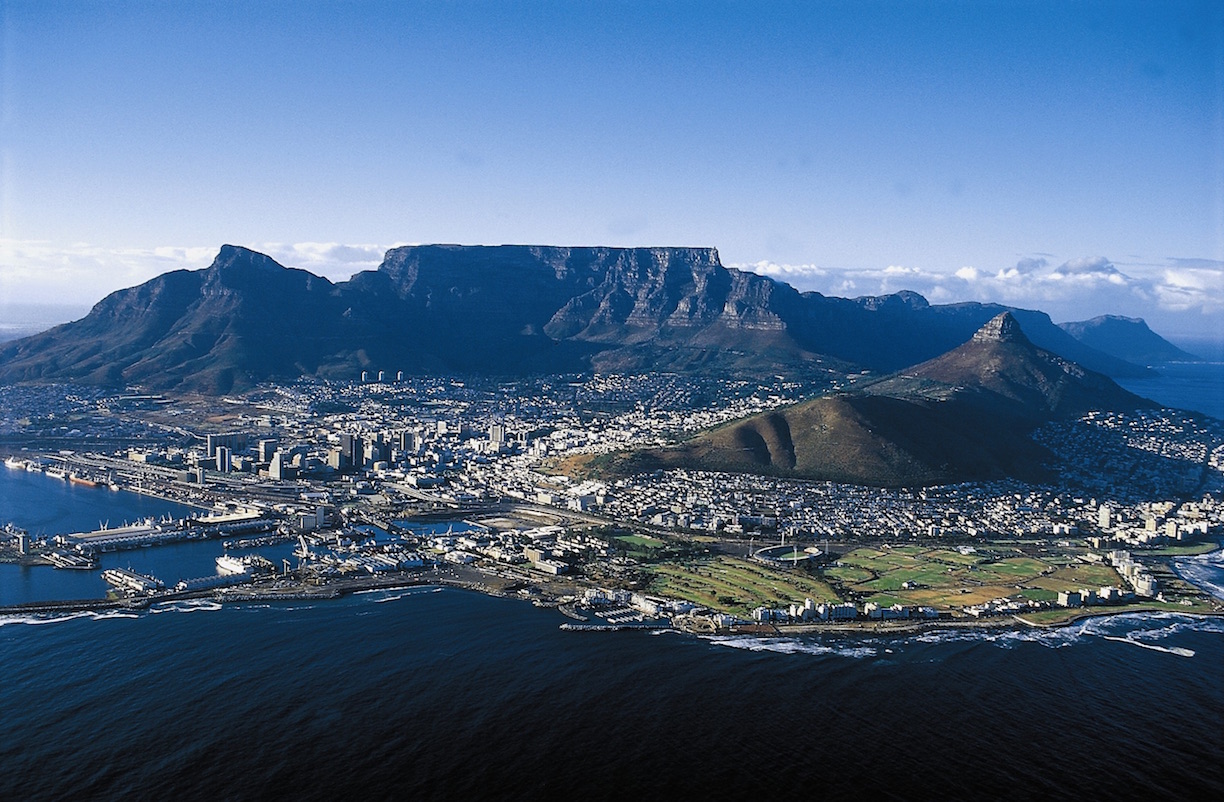
No matter how many times I clicked
through the photos online before my first trip to
South Africa, those images of jacaranda trees
backlit by fiery sunsets, of thick-tusked
elephants loping along the veld, of Table Mountain
(above)
in its regal repose, the water glistening so
unexpectedly close to its base, I just hadn’t been
prepared for the light when I actually got there.
The clarity of that light, whether the explosive
pinks and purples of the sunsets in the bush or
the more subtly shimmering blues of morning in the
Western 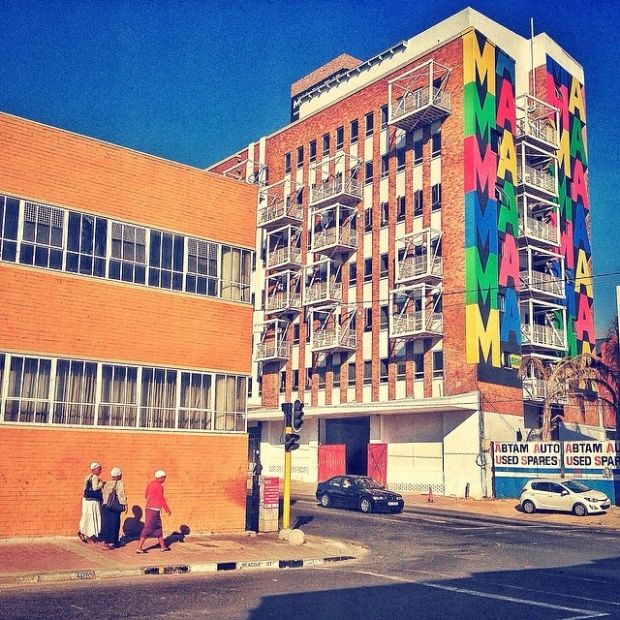 Cape, the sun, and the
way it shone, was a constant source of fascination
for me during the time I have spent in South
Africa.
Cape, the sun, and the
way it shone, was a constant source of fascination
for me during the time I have spent in South
Africa.
Among so many of the travel,
wine, spirits, and food writers that I know and have
journeyed with, South Africa, at some point,
invariably comes up in the conversation. It’s one of
those destinations that is at the top of seemingly
all of my colleagues’ travel bucket lists. First in
November 2014, and then again this past June, I had
the good fortune to visit the country on trips
hosted by South African Tourism. Key parts
of the trips were also run in conjunction with Roots
Africa Tours.
Over the course of a combined 16
days, I had the chance to not just see the sights
but also to experience first-hand so much of what
makes the country one of the top destinations on the
planet—from the energy of Johannesburg’s Maboneng
Precinct (left),
with its streets bustling with stylish young people
strolling along as music and the smell of fried food
hovers in the air, to the sophistication of Cape
Town, one of the most beautiful cities I’ve ever
visited, its office and hotel towers giving way to
the lower-lying residential areas spread out beyond,
the Technicolor houses of the Bo-Kaap neighborhood
and the electric energy of Kloof Street, to the
movie-set beauty of a safari up north in Huidspruit,
out east beyond Port Elizabeth.
Personally, with two very young
children and therefore a distinct lack of sleep in
my home life, I welcomed the nonstop South African
Airways flight to South Africa. At the
time, I was training for the Philadelphia Marathon,
so when I awoke a little after sunrise that first
day, I
stretched out in my bed at the remarkable Le Petite Dauphine
Guest Farm in Franschhoek, and felt
better prior to my early-morning jog than I had back
in Philadelphia. Out my front door, along the trails
lining the expansive five-star property, through the
front gate and up along the rolling roads stretching
toward the horizon, I ran off what few cobwebs there
were from the journey halfway around the world,
breathed in air perfumed with a profusion of
springtime flowers and trees bursting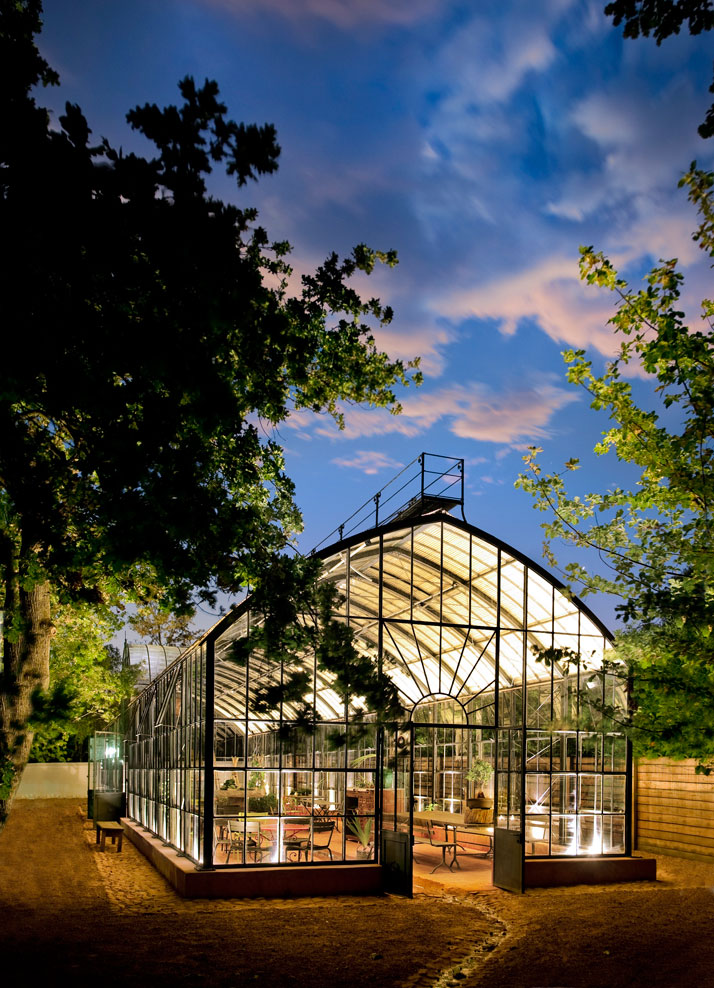 with
blossoms, and watched the clouds roll over and down
the flanks of the Drakenstein Mountains off in the
distance as the sky lightened from a deep to a paler
blue as the sun continued its climb.
with
blossoms, and watched the clouds roll over and down
the flanks of the Drakenstein Mountains off in the
distance as the sky lightened from a deep to a paler
blue as the sun continued its climb.
Showered, refreshed and by then
ravenously hungry, I met up for breakfast with the
rest of the group. I tucked into fresh eggs and
fruit taken from a stone’s throw away. This, I would
soon discover, was one of the many reasons to travel
to South Africa: The range and expressiveness of the
local culinary culture is stunning.
My deep respect for what this
storied land can produce was beautifully embodied in
Babylonstoren
(right), a
massive 500-acre Cape Dutch farm in the Drakenstein
Valley, with roots that stretch back to 1690. Today,
with its endless fields of flowers and fruit trees,
vegetables and ducks and more—there is even a maze
of prickly pear—this is a breathtaking property
replete with a hotel and a vineyard. Even if you’re
not staying the night, a meal at the excellent Babel
restaurant or in the Greenhouse, hydrated with a
spot of herb-perfumed tea, is a phenomenal way to
spend a day while you’re exploring the areas around
Franschhoek and Paarl.
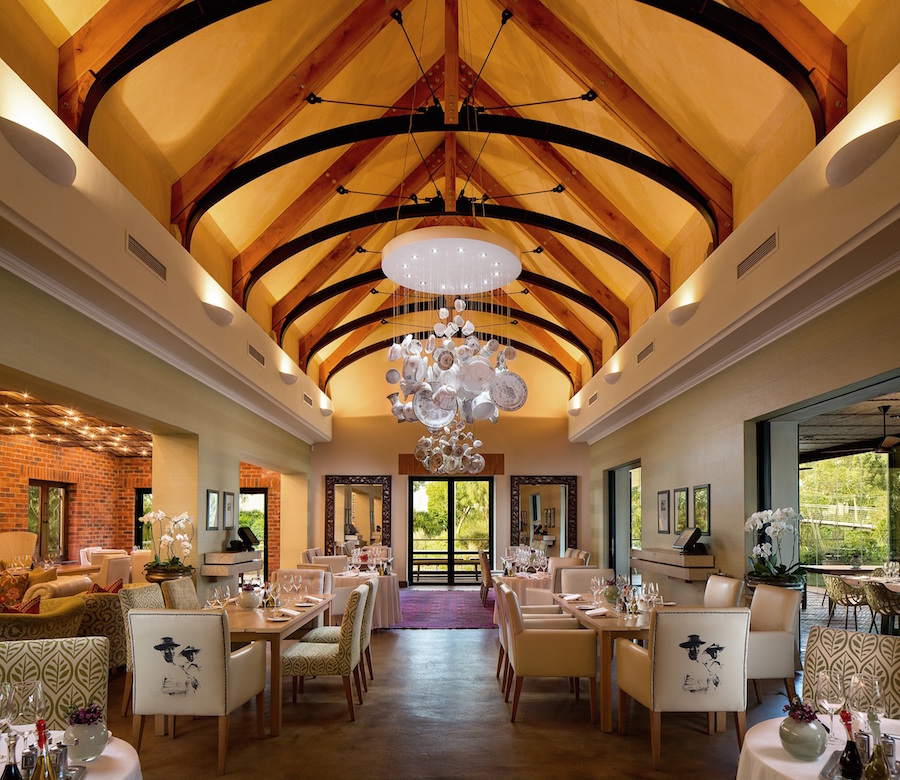 In
a similar vein is Pierneef à
la Motte (left), another
restaurant connected to a grape-growing and farming
operation. The sophisticated, rustic-chic restaurant
cooks up some seriously accomplished dishes, among
the most memorable a fermented mushroom that
contextualized the fungus in a way I’d never before
considered. The menu is wide-ranging, no matter how
guests choose
to eat. A
vegan, gluten-free lemon and vanilla cashew tart
finds a place on the menu alongside heartier fare
like baked bone marrow with grilled potato and leek
bread, pickled ox tongue and parsley salad.
In
a similar vein is Pierneef à
la Motte (left), another
restaurant connected to a grape-growing and farming
operation. The sophisticated, rustic-chic restaurant
cooks up some seriously accomplished dishes, among
the most memorable a fermented mushroom that
contextualized the fungus in a way I’d never before
considered. The menu is wide-ranging, no matter how
guests choose
to eat. A
vegan, gluten-free lemon and vanilla cashew tart
finds a place on the menu alongside heartier fare
like baked bone marrow with grilled potato and leek
bread, pickled ox tongue and parsley salad.
South Africa in general, and the
Western Cape in particular, is home to a stunning
range of artisanal food producers. World-class
smoked salmon and trout from a hatchery at Franschhoek
Three Streams Trout Farm were a
revelation. Delicious sweets at Huguenot Fine
Chocolates, also in downtown Franschhoek, are worth
stocking up on. Outside the town is Terbodore Coffee
Roasters, which brings in raw beans from around
Africa and the rest of the world and roasts them in
small batches.
Noble Hill Estate,
in Paarl, is helmed by Kathleen and Kristopher
Tillery, a mother-and-son team from the United
States,  and their wines are remarkable, as are
the chili peppers they grow. Stokkiesdraai Biltong
at the Victoria & Alfred Waterfront Food Market
is a carnivore’s fantasy. I purchased a sizable bag
of ostrich and beef biltong—imagine the best jerky
you’ve ever had—early on my last trip, and happily
snacked my way through it over the course of my
stay.
and their wines are remarkable, as are
the chili peppers they grow. Stokkiesdraai Biltong
at the Victoria & Alfred Waterfront Food Market
is a carnivore’s fantasy. I purchased a sizable bag
of ostrich and beef biltong—imagine the best jerky
you’ve ever had—early on my last trip, and happily
snacked my way through it over the course of my
stay.
Chefs
like the visionary Chris Erasmus of Foliage Restaurant
(right) at
the IS Art Gallery (also worth a visit for its
gorgeous range of local artists and, given the
friendly exchange rate, excellent values on
one-of-a-kind artwork), are pushing the boundaries
of what South African cuisine is and can be. Using
local and seasonal ingredients, many of them
foraged, in new and unexpected ways, a dinner at
Foliage is an eye-opening and soul-satisfying
experience. The menu changes, but you’re
likely to find phenomenal dishes like a braised kudu
shank boudin with roasted bone marrow, grilled
springbok, purslane, honeybush jus, and
mushroom and oyster, among many others.
Part Two of this article will appear May 8.
❖❖❖
By John Mariani
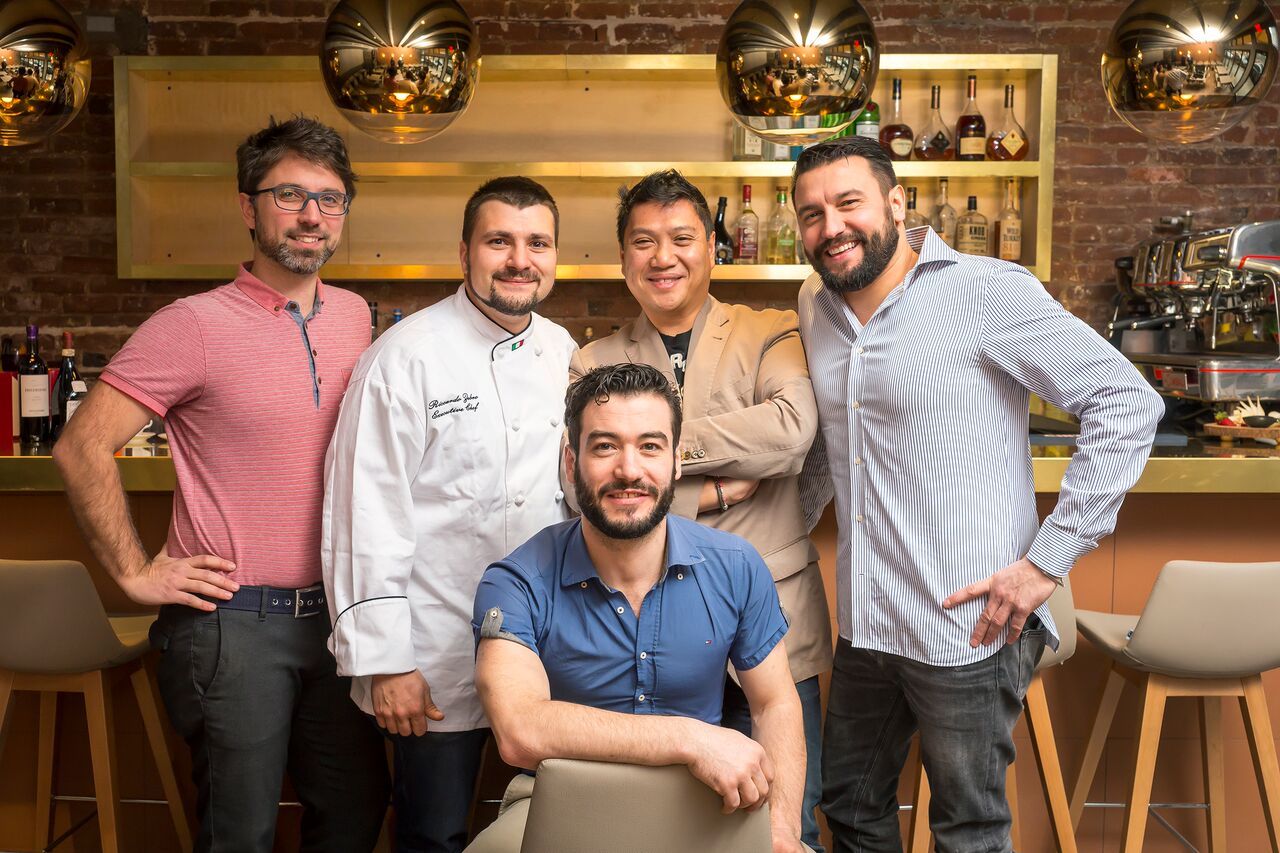 SAN
CARLO
SAN
CARLO OSTERIA PIEMONTE
90 Thompson Street (near Prince Street)
212-625-1212
sancarlonyc.com
As
far as I know, NYC has only two true Piedmontese
restaurants—the venerable Barbetta, opened in
1906, and the brand new San Carlo Osteria
Piemonte.
One could hardly be different from the
other in terms of atmosphere, for Barbetta is a
townhouse resplendent in baroque and 19th
century antiques, while San Carlo, with just 50
seats, is as modern as a new Alfa-Romeo Spider. Yet
both share a true dedication to the cuisine of
that northern Italian region and its capital,
Turin, whose famous broad piazza gives its name
to this little osteria in SoHo. 
There are three enthusiastic
partners behind San Carlo, all natives of
Turin: CEO Carlo Rolle, a Turin restaurateur; Managing
Director Moreno Cerutti, a former marketing
executive; and
Davide Poggi, former General Manager of the
nearby Piccola Cucina. In the
kitchen is the ebullient Chef Riccardo Zebro, who
trained in notable restaurants like Balzi
Rossi in Ventimiglia and Il Milanese
Curioso in Milan.
Outside is an engraved brass
bull, a Piedmontese symbol for good luck.
Inside is a mural of Piazza San Carlo, the now
commonplace exposed brick walls, wood floors, and
beamed ceilings, with an accent wall made
with terracotta tiles, and a brass bar on the
opposite side.
The chairs and banquettes are exceptionally
comfortable, especially for SoHo, where rude wood
rules. The
lighting is just right, glowing from brass
sconces, but the place can get loud when it’s
full, which means there is no reason whatsoever
for the owners to pound in music you can’t even
recognize.
The ambiance is casual and
guests are meant to have a good time, but the
cooking at San Carlo is very serious indeed. Just
the texture alone of the housemade cooked pastas
tells you it is as close as you’ll find to the
real thing in Italy—not merely al dente but light,
with the right chewiness and the proper amount of
sauce. Moreno
Cerrutti bounds around the room greeting, coaxing,
recommending and pleasing his clientele, which
currently runs to neighborhood people walking in
off the street to see what San Carlo is all about. I
shudder to think how tough it will be to get a
table here once the word really gets out.
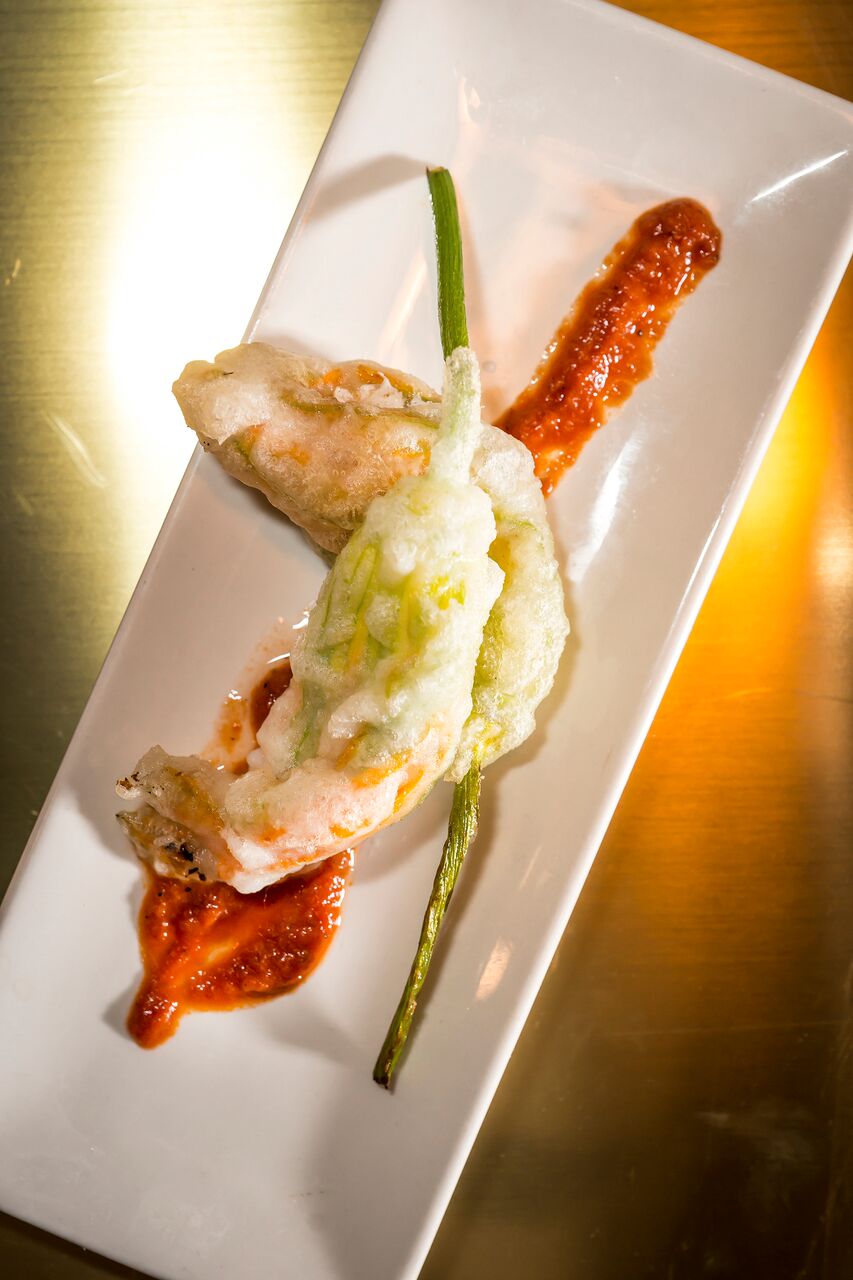 Begin
with a sip of lightly sparkling Prosecco Foss
Marai ($12) and nibble on the crisp, hot fried
squash blossoms oozing with mozzarella and basil. A
selection of salumi ($14
and
$19) goes well with the good crusty bread and
green-gold olive oil here, and for antipasti, by
all means have one of the classic Piedmontese
preparations—vitello
tonnato, made with thinly sliced veal in a
creamy tuna and capers sauce, with the novel
addition of pickled onions ($15). You
might find this dish elsewhere around town, but at
San Carlo it is done to perfection. Capunet
ripieno ($12) are stuffed cabbage rolls,
lush with a fonduta
of melted taleggio cheese.
Begin
with a sip of lightly sparkling Prosecco Foss
Marai ($12) and nibble on the crisp, hot fried
squash blossoms oozing with mozzarella and basil. A
selection of salumi ($14
and
$19) goes well with the good crusty bread and
green-gold olive oil here, and for antipasti, by
all means have one of the classic Piedmontese
preparations—vitello
tonnato, made with thinly sliced veal in a
creamy tuna and capers sauce, with the novel
addition of pickled onions ($15). You
might find this dish elsewhere around town, but at
San Carlo it is done to perfection. Capunet
ripieno ($12) are stuffed cabbage rolls,
lush with a fonduta
of melted taleggio cheese.
Among the pastas is a
good-sized portion of agnolotti with
juicy,
braised meat and a veal jus
($20) and egg-rich tajarin—the
Piedmontese
name for tagliarine
or tagliatelle—in
a quickly cooked sauce of chanterelle mushrooms
and veal ragù
($19). Potato
gnocchi
are airy and lavished with a Piedmontese cheese
sauce studded with toasted walnuts ($17). I 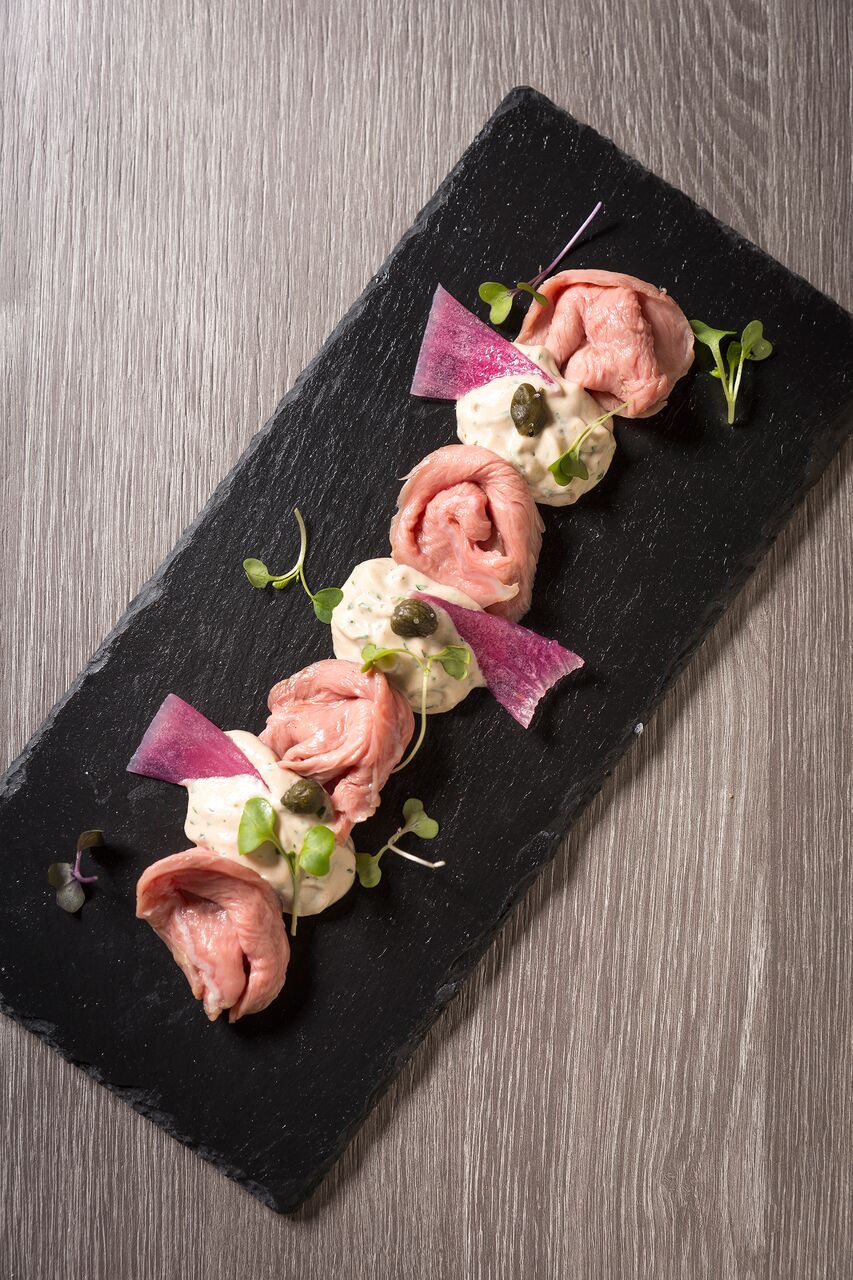 will return to try
their risotto with Castelmagno cheese ($21) and
pray they will someday soon serve my favorite
Turinese dish, the thumbnail-size agnolotti del
plin, which are customarily served in a
clean white napkin.
will return to try
their risotto with Castelmagno cheese ($21) and
pray they will someday soon serve my favorite
Turinese dish, the thumbnail-size agnolotti del
plin, which are customarily served in a
clean white napkin.
Piedmont’s cooks have always taken their
time making their meat sauces, and the
slowly-braised beef cheek here proves why. All the
ingredients and seasonings are suffused throughout
meat that falls apart in shreds, accompanied by
nutty buckwheat polenta and baby carrots ($27).
San Carlo does a fine Cornish game hen alla babi,
so-called because it is pressed and grilled and
looks like a babi—toad—here
served with scented baby potatoes and wild
mushrooms ($24).
The grilled fish of the day will be
pleasant if not thrilling, as Italian-style fish
dishes so rarely are in New York.
This food is rich but not
particularly heavy, so you’ll have room for
desserts like the egg-whipped zabaione with sweet
wine and cookies, or the delicious Piedmontese
chocolate custard classic bonèt
with amaretti.
San
Carlo’s wine list is building up to 150
labels, with 10 by the glass, focused on regional
wines of the north, not least Piedmont’s own great
Barolo and Barbarescos. And, since Turin has
inspired more than its share of cocktails, like
the Milano Torino and the Americano, there is a
good spirits list too.
I’m hoping the inevitable popularity of San Carlo
does not overwhelm this precious little trattoria,
for a good deal of the fun is to intermingle with
the staff and sense that life is too short not to
take your time eating food of this unusual kind.
Open
for lunch and dinner daily.
❖❖❖
By Geoff Kalish
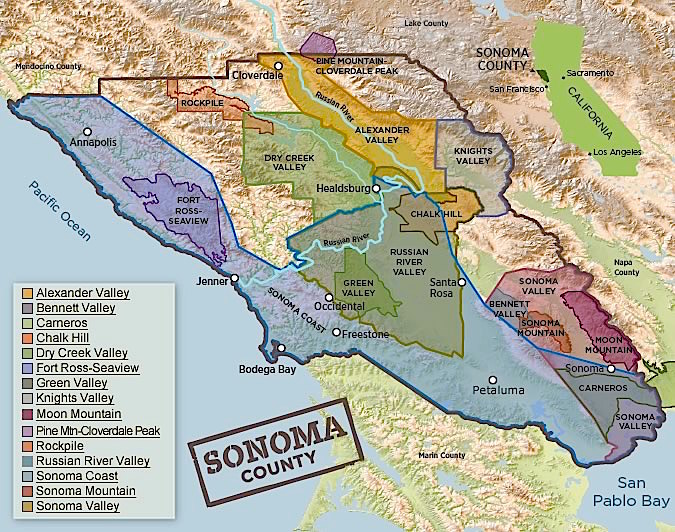
Jordan
Vineyard & Winery
1474
Alexander Valley Road, Healdsburg
707-431-5250
www.jordanwinery.com
 Tom Jordan made his money in oil in
Colorado and in the late 1960s and early 1970s
traveled through France with his wife, Sally, to
try to buy a chȃteau producing top-quality wine.
Unable to find what he wanted, he built a
“Chȃteau” in Alexander Valley. He
hired a young winemaker, Rob Davis, and contracted
for the consulting services of renowned enologist André
Tchelistcheff (creator of the iconic Napa Valley
Beaulieu Vineyard “Georges de Latour Private
Reserve” Cabernets).
Tom Jordan made his money in oil in
Colorado and in the late 1960s and early 1970s
traveled through France with his wife, Sally, to
try to buy a chȃteau producing top-quality wine.
Unable to find what he wanted, he built a
“Chȃteau” in Alexander Valley. He
hired a young winemaker, Rob Davis, and contracted
for the consulting services of renowned enologist André
Tchelistcheff (creator of the iconic Napa Valley
Beaulieu Vineyard “Georges de Latour Private
Reserve” Cabernets).
The first vintage of Jordan
Cabernet in 1976,
made using barrels purchased from Château
Lafite Rothschild (which some say contained
Lafite), received
spectacular reviews and ratings and was compared
with the wines of top-tier French producer Château
Margaux. Now
producing 100,000 cases of wine annually and owned
and operated by Tom Jordan’s son, John, the winery
is also making a well-regarded Chardonnay. When
asked about the possibility of producing other
types of wine, John commented that “we do not plan
to make more than just a Cabernet and
Chardonnay.”
Recent Releases
2011
Cabernet Sauvignon ($55)—Fragrant bouquet
of cassis and plums, with well integrated taste of
herbs, oak and dark fruit, and long finish with a
touch of tannin, which makes for good
accompaniment to charbroiled steak and lamb.
2013
Chardonnay ($33)—Bouquet and taste of ripe
apples and butterscotch with a lively finish;
perfect to mate with sea fare and grilled chicken.
With
advance reservations visitors are accepted for a
variety of one- to three-hour tour and tasting
programs.
Robert
Young Estate Winery
4960 Red Winery Road, Geyserville
707-431-4811
www.ryew.com
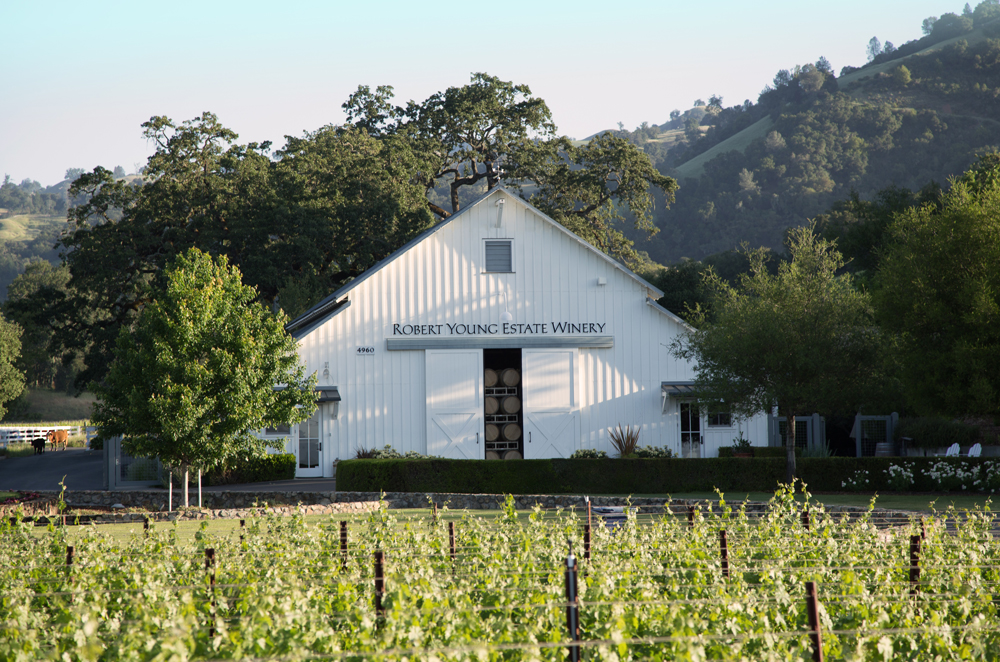 In 1965 Robert
Young began planting grapes on the 200-acre parcel
his family had owned and farmed since the 1850s.
As with other Alexander Valley properties the
grapes were initially sold to other wineries for
their use in wines (some good and some not so
good). However the wines made from Robert Young
Vineyard Chardonnay grapes fashioned by Richard
Arrowood were some of the best received and best
known of Sonoma
County. And in 1997, with his father’s blessing,
Fred Young began producing and selling wine from
the grapes grown on the estate. Today
three different Chardonnays and seven reds are
produced under the direction of winemaker Kevin
Warren.
In 1965 Robert
Young began planting grapes on the 200-acre parcel
his family had owned and farmed since the 1850s.
As with other Alexander Valley properties the
grapes were initially sold to other wineries for
their use in wines (some good and some not so
good). However the wines made from Robert Young
Vineyard Chardonnay grapes fashioned by Richard
Arrowood were some of the best received and best
known of Sonoma
County. And in 1997, with his father’s blessing,
Fred Young began producing and selling wine from
the grapes grown on the estate. Today
three different Chardonnays and seven reds are
produced under the direction of winemaker Kevin
Warren.
A Sampling of Recent Releases
2013 Alexander Valley
Estate Chardonnay ($42 )—This wine has a
bouquet and taste of citrus, pears and hints of
peaches and almonds with a moderate amount of
acidity in its finish.
2012 Barrel Select
Estate Chardonnay ($49)—Showing a bouquet
of ripe papaya and lemons, this wine shows layers
of fruit and vanilla with a long memorable finish.
2011 Scion Cabernet
Sauvignon ($65)—Aromas of blackberries
and ripe cherries dominate in the bouquet and
taste, with a lingering flavor of vanilla in its
soft finish.
The
small tasting room is open to visitors daily
(except major holidays and for special events)
10 a.m. – 4:30 p.m. With advanced reservations,
guided one-hour walking tours are available on
most Saturdays and Sundays.
White
Oak
7505
California Highway 128, Healdsburg
707-433-8420
www.whiteoakwinery.com
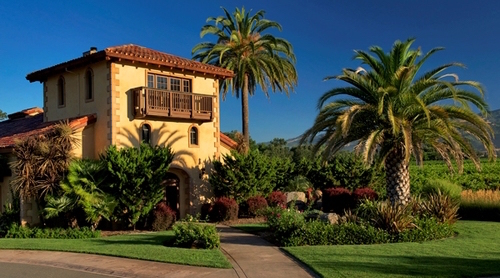 From
its initial, small Alexander Valley vineyard and
tasting room just off the square in Healdsburg in
the 1970s, owner Bill Myers has gown this winery
to produce award-winning bottles from over 750
acres of prime land, including parcels in
Alexander, Russian River and Napa valleys. And,
although only about 10% of the harvest is used for
wines under the White Oak label (21,000 cases),
other producers are having great success with the
grapes from Myers’ holdings. However, while its
wine and winemaker William Parker win numerous
accolades on the West Coast, recognition is only
beginning in the eastern markets.
From
its initial, small Alexander Valley vineyard and
tasting room just off the square in Healdsburg in
the 1970s, owner Bill Myers has gown this winery
to produce award-winning bottles from over 750
acres of prime land, including parcels in
Alexander, Russian River and Napa valleys. And,
although only about 10% of the harvest is used for
wines under the White Oak label (21,000 cases),
other producers are having great success with the
grapes from Myers’ holdings. However, while its
wine and winemaker William Parker win numerous
accolades on the West Coast, recognition is only
beginning in the eastern markets.
A Sampling of Recent Releases
2013
Russian River Valley Sauvignon Blanc ($17)—This
well-priced white shows a bouquet and taste of
citrus and nectarines with a lively acidity in its
finish.
2013
Russian River Valley Chardonnay ($24)—With
a bouquet and taste of tropical fruit, hints of
baked apple and a citrusy finish, this wine is
perfect to pair with a wide range of sea fare from
oysters to Arctic char and grilled salmon.
2013
Russian River Valley Pinot Noir ($35)—This
Fifty Best Double-Gold Medal winner shows a
bouquet of deep red fruit, chocolate and sage,
with a well-integrated, elegant taste of plums,
herbs and oak and a smooth long-lasting finish.
2012 Napa Valley
Cabernet Sauvignon ($35)—A bouquet and
taste of figs, plums and cassis dominate in this
complex wine that has firm tannins and will need
3-5 years to show its best.
The
winery is open for tastings and picnics in its
scenic grove 10 a.m. – 5 p.m. daily (except
major holidays).
❖❖❖
 GREAT MARKETING IDEAS
GREAT MARKETING IDEAS
OF THE 21ST CENTURY
After intense marketing studies and
compiling massive data, Burger King announced that it's
adding hot dogs to its menu, one with the
standard fixings of ketchup, mustard, onions, and
relish (left);
and another with chili and cheese (right).
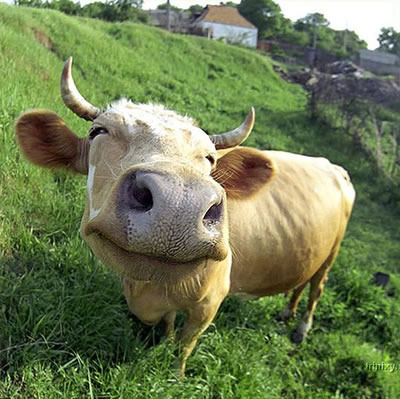 MOST
ANTI-CLIMACTIC OPENING
MOST
ANTI-CLIMACTIC OPENING
LINE OF THE 21ST CENTURY
“Brined in sweat
and covered in Hong Kong’s humidity, I pushed myself to
amble up a dirt path.
Finally, there was a bus stop—and next to it, a
cow, waiting.”—Chaney Kwak, “Hiking Hong Kong,” Delta Sky
(January, 2016)
Any of John Mariani's books below may be ordered from amazon.com.
 The Hound in Heaven
(21st Century Lion Books) is a novella, and
for anyone who loves dogs, Christmas, romance,
inspiration, even the supernatural, I hope you'll find
this to be a treasured favorite. The story
concerns how, after a New England teacher, his wife and
their two daughters adopt a stray puppy found in their
barn in northern Maine, their lives seem full of promise.
But when tragedy strikes, their wonderful dog Lazarus and
the spirit of Christmas are the only things that may bring
his master back from the edge of despair.
The Hound in Heaven
(21st Century Lion Books) is a novella, and
for anyone who loves dogs, Christmas, romance,
inspiration, even the supernatural, I hope you'll find
this to be a treasured favorite. The story
concerns how, after a New England teacher, his wife and
their two daughters adopt a stray puppy found in their
barn in northern Maine, their lives seem full of promise.
But when tragedy strikes, their wonderful dog Lazarus and
the spirit of Christmas are the only things that may bring
his master back from the edge of despair. WATCH THE VIDEO!
“What a huge surprise turn this story took! I was completely stunned! I truly enjoyed this book and its message.” – Actress Ali MacGraw
“He had me at Page One. The amount of heart, human insight, soul searching, and deft literary strength that John Mariani pours into this airtight novella is vertigo-inducing. Perhaps ‘wow’ would be the best comment.” – James Dalessandro, author of Bohemian Heart and 1906.
“John Mariani’s Hound in Heaven starts with a well-painted portrayal of an American family, along with the requisite dog. A surprise event flips the action of the novel and captures us for a voyage leading to a hopeful and heart-warming message. A page turning, one sitting read, it’s the perfect antidote for the winter and promotion of holiday celebration.” – Ann Pearlman, author of The Christmas Cookie Club and A Gift for my Sister.
“John Mariani’s concise, achingly beautiful novella pulls a literary rabbit out of a hat – a mash-up of the cosmic and the intimate, the tragic and the heart-warming – a Christmas tale for all ages, and all faiths. Read it to your children, read it to yourself… but read it. Early and often. Highly recommended.” – Jay Bonansinga, New York Times bestselling author of Pinkerton’s War, The Sinking of The Eastland, and The Walking Dead: The Road To Woodbury.
“Amazing things happen when you open your heart to an animal. The Hound in Heaven delivers a powerful story of healing that is forged in the spiritual relationship between a man and his best friend. The book brings a message of hope that can enrich our images of family, love, and loss.” – Dr. Barbara Royal, author of The Royal Treatment.
 |
The Encyclopedia of American Food and Drink by John F. Mariani (Bloomsbury USA, $35) Modesty forbids me to praise my own new book, but let me proudly say that it is an extensive revision of the 4th edition that appeared more than a decade ago, before locavores, molecular cuisine, modernist cuisine, the Food Network and so much more, now included. Word origins have been completely updated, as have per capita consumption and production stats. Most important, for the first time since publication in the 1980s, the book includes more than 100 biographies of Americans who have changed the way we cook, eat and drink -- from Fannie Farmer and Julia Child to Robert Mondavi and Thomas Keller. "This book is amazing! It has entries for everything from `abalone' to `zwieback,' plus more than 500 recipes for classic American dishes and drinks."--Devra First, The Boston Globe. "Much needed in any kitchen library."--Bon Appetit. |
"Eating Italian will never be the same after reading John Mariani's entertaining and savory gastronomical history of the cuisine of Italy and how it won over appetites worldwide. . . . This book is such a tasteful narrative that it will literally make you hungry for Italian food and arouse your appetite for gastronomical history."--Don Oldenburg, USA Today. "Italian
restaurants--some good, some glitzy--far
outnumber their French rivals. Many of
these establishments are zestfully described
in How Italian Food Conquered the World, an
entertaining and fact-filled chronicle by
food-and-wine correspondent John F.
Mariani."--Aram Bakshian Jr., Wall Street
Journal.
"Equal parts
history, sociology, gastronomy, and just
plain fun, How Italian Food Conquered the
World tells the captivating and delicious
story of the (let's face it) everybody's
favorite cuisine with clarity, verve and
more than one surprise."--Colman Andrews,
editorial director of The Daily
Meal.com. "A fantastic and fascinating
read, covering everything from the influence
of Venice's spice trade to the impact of
Italian immigrants in America and the
evolution of alta cucina. This book will
serve as a terrific resource to anyone
interested in the real story of Italian
food."--Mary Ann Esposito, host of PBS-TV's
Ciao
Italia. "John Mariani has written the
definitive history of how Italians won their
way into our hearts, minds, and
stomachs. It's a story of pleasure over
pomp and taste over technique."--Danny Meyer,
owner of NYC restaurants Union Square
Cafe, The Modern, and Maialino.
|
 |
 |
 |
 |
 |
 |
 |
 |
 Everett Potter's Travel Report:
Everett Potter's Travel Report: 
 Eating Las
Vegas JOHN CURTAS has been covering
the Las Vegas food and restaurant scene
since 1995. He is the co-author of EATING LAS
VEGAS – The 50 Essential Restaurants (the
fourth edition of which will be published in
early 2016), as well as the author of the Eating Las
Vegas web site: www.eatinglasvegas.
He can also be seen every Friday morning as
the “resident foodie” for Wake Up With the
Wagners on KSNV TV (NBC) Channel 3 in
Las Vegas.
Eating Las
Vegas JOHN CURTAS has been covering
the Las Vegas food and restaurant scene
since 1995. He is the co-author of EATING LAS
VEGAS – The 50 Essential Restaurants (the
fourth edition of which will be published in
early 2016), as well as the author of the Eating Las
Vegas web site: www.eatinglasvegas.
He can also be seen every Friday morning as
the “resident foodie” for Wake Up With the
Wagners on KSNV TV (NBC) Channel 3 in
Las Vegas.

MARIANI'S VIRTUAL GOURMET
NEWSLETTER is published weekly. Editor/Publisher: John
Mariani.
Editor: Walter Bagley. Contributing Writers: Christopher Mariani,
Robert Mariani, Misha
Mariani,
John A. Curtas, Edward Brivio, Mort Hochstein,
Andrew Chalk, Dotty Griffith and Brian Freedman. Contributing
Photographers: Galina Dargery, Bobby
Pirillo. Technical Advisor: Gerry McLoughlin.
To un-subscribe from this newsletter,click here.
© copyright John Mariani 2016

